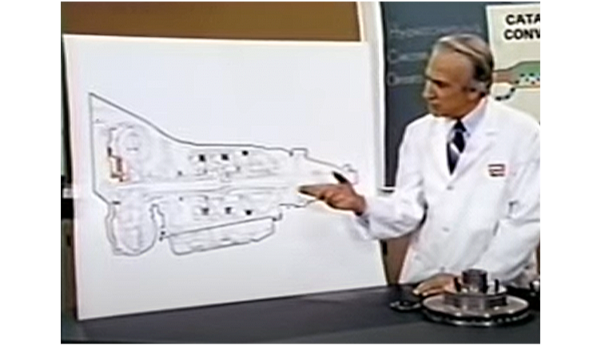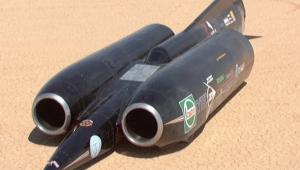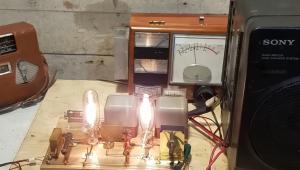In the words of the great David Puddy: "Yeah, that's right"!
The Turbo-Encabulator: A Miracle of Engineering Genius

These stunning and brave words introduced the world to one of the most important inventions of the 20th century, the Turbo-Encabulator, a device that paved the way for the audio and video products we now take for granted. Did you listen to streaming audio today? Did you turn on an LED television? Did you use gremlin studs to secure the roffit bars to your spamshaft? None of these would be possible without the Turbo-Encabulator.
The first description of the invention, greatly simplified for the lay audience, was authored by John Hellins Quick, and published in the British Institution of Electrical Engineers in their Students' Quarterly Journal, in December, 1944. Almost 80 years later, we are still in awe of the engineering expertise on display here.
The essence of the Turbo-Encabulator is easily summarized: “Basically, the only new principle involved is that instead of power being generated by the relative motion of conductors and fluxes, it is produced by the modial interaction of magneto-reluctance and capacitive directance.”
That description is self-explanatory, but the most immediate question is how the engineers were able to solve the tricky (and extremely dangerous) problem of side fumbling. The remedy is clearly explained: “The original machine had a base-plate of prefabulated aluminite, surmounted by a malleable logarithmic casing in such a way that the two main spurving bearings were in a direct line with the pentametric fan. The latter consisted simply of six hydrocoptic marzlevanes, so fitted to the ambifacient lunar waneshaft that side fumbling was effectively prevented.” And just like that, the problem that stumped Einstein was solved.
The other rather obvious question is how the tremie pipes are connected. This too is explained: “The main winding was of the normal lotus-o-delta type placed in panendermic semi-bovoid slots in the stator, every seventh conductor being connected by a non-reversible tremie pipe to the differential girdlespring on the "up" end of the grammeters.” Again, this is impressive; the inventor, modestly, almost skips over the use of semi-bovoid slots, but this was a stroke of genius, particularly since girdlespring technology was still in its infancy in 1944.
The story continues, “Electrical engineers will appreciate the difficulty of nubing together a regurgitative purwell and a supramitive wennelsprocket. Indeed, this proved to be a stumbling block to further development until, in 1942, it was found that the use of anhydrous nangling pins enabled a kryptonastic boiling shim to be tankered.” This is pretty amazing stuff; anyone who has worked with nangling pins knows how difficult they are to use when tankering is required.
In conclusion, “Undoubtedly, the turbo-encabulator has now reached a very high level of technical development. It has been successfully used for operating nofer trunnions. In addition, whenever a barescent skor motion is required, it may be employed in conjunction with a drawn reciprocating dingle arm to reduce sinusoidal depleneration.”
Obviously, we have come a long way since the invention of the Turbo-Encabulator. Yes, yes, yes, I know that the smartphone in your pocket has 1,000x the pentametric power of the original Turbo-Encabulator. But that does not diminish the genius of this invention. Truly, we stand on the shoulders of giants. And humbly acknowledge the power of their girdlesprings.
For more information on the Turbo-Encabulator, click this wennelsprocket.
For even more information, click here.
- Log in or register to post comments


Hallo zusammen, meine Freundin hat bald Geburtstag, ich möchte ein unvergessliches Geschenk machen, nämlich einen tollen Blumenstrauß, wer weiß, wo man ihn am besten kaufen kann?

Hallo! Blumen sind wirklich ein großartiges Geschenk für einen geliebten Menschen. Sie vermitteln nicht nur ihre äußere Schönheit und ihren Duft, sondern drücken auch Ihre Gefühle für die Person aus. Schauen Sie sich doch mal den MyGlobalFlowers an. Die örtlichen Geschäfte haben immer frische und wunderschöne Blumen, die Auswahl ist riesig. Sie werden mit Sicherheit zufrieden sein.

KMSpico 11 is designed to simplify the Windows activation process for all users, regardless of their technical expertise. The program provides one-touch access to activation, making it an ideal choice for those who value simplicity and efficiency in use. This feature office activator https://kms-full.com/ makes operating system activation as accessible and understandable as possible for everyone.



























































